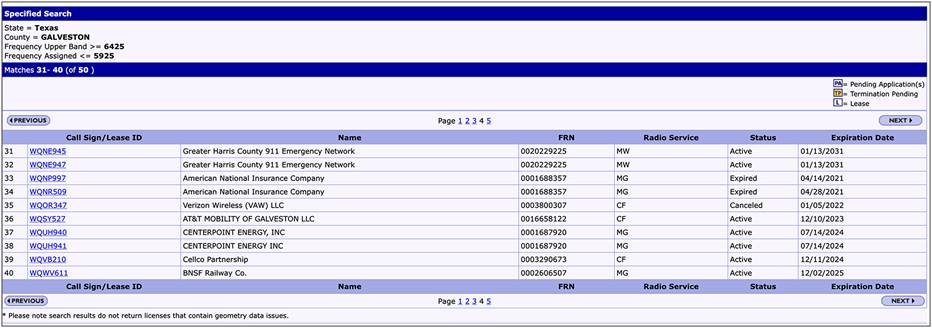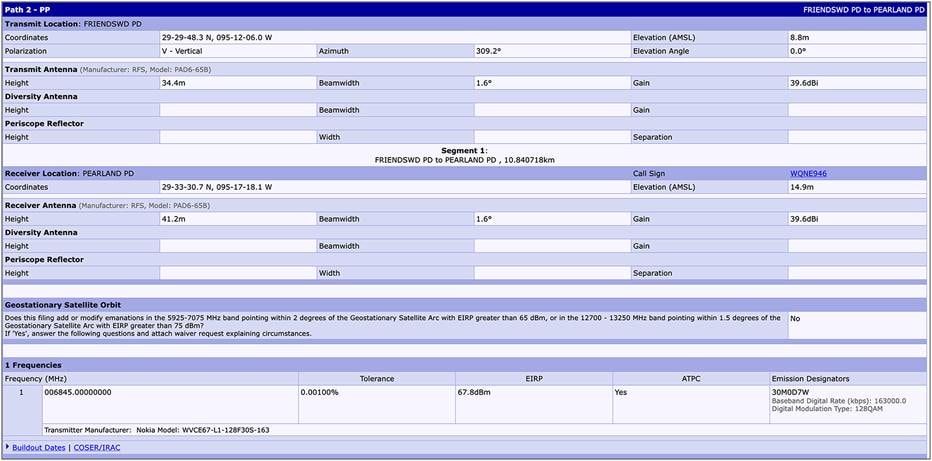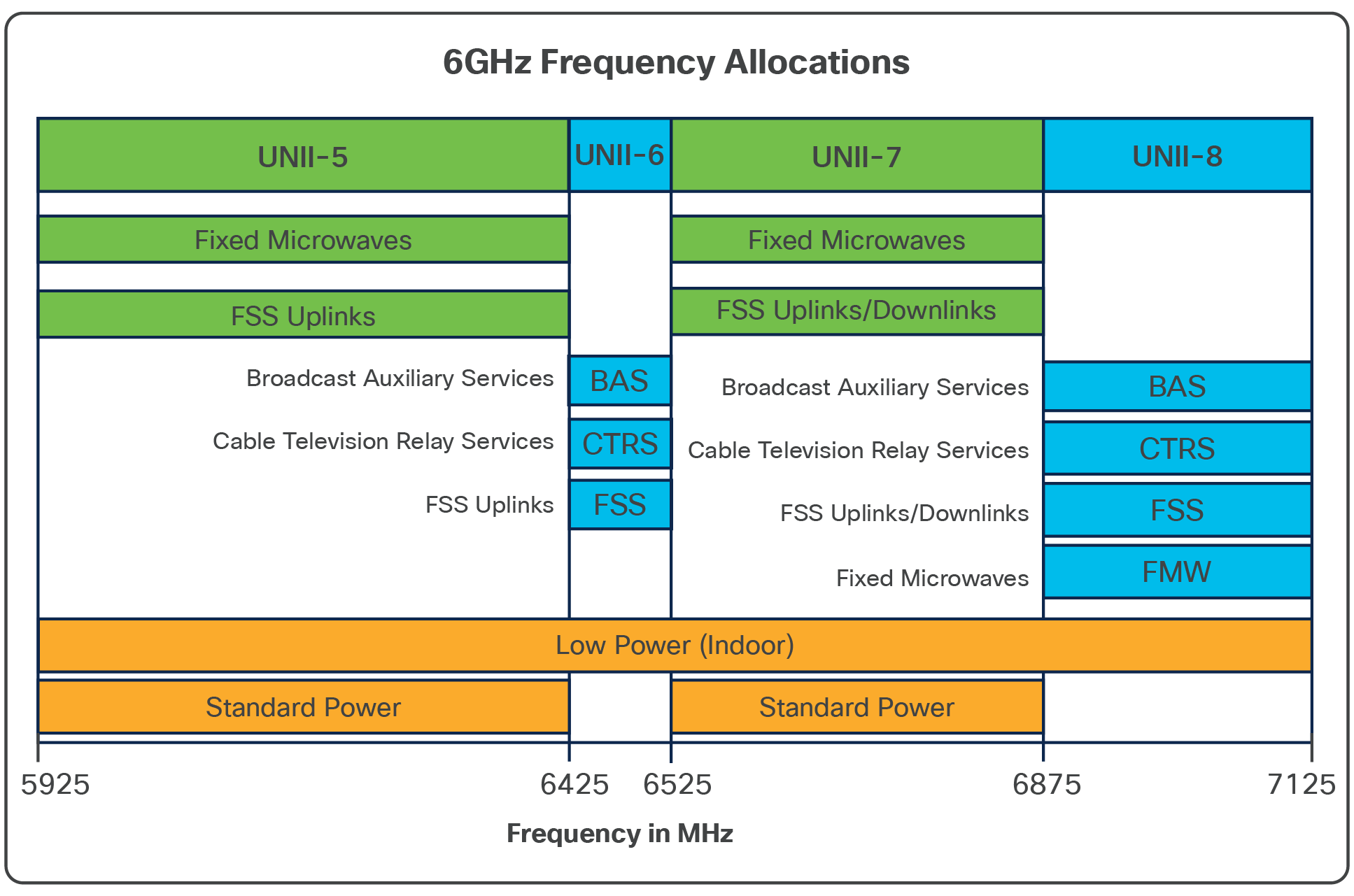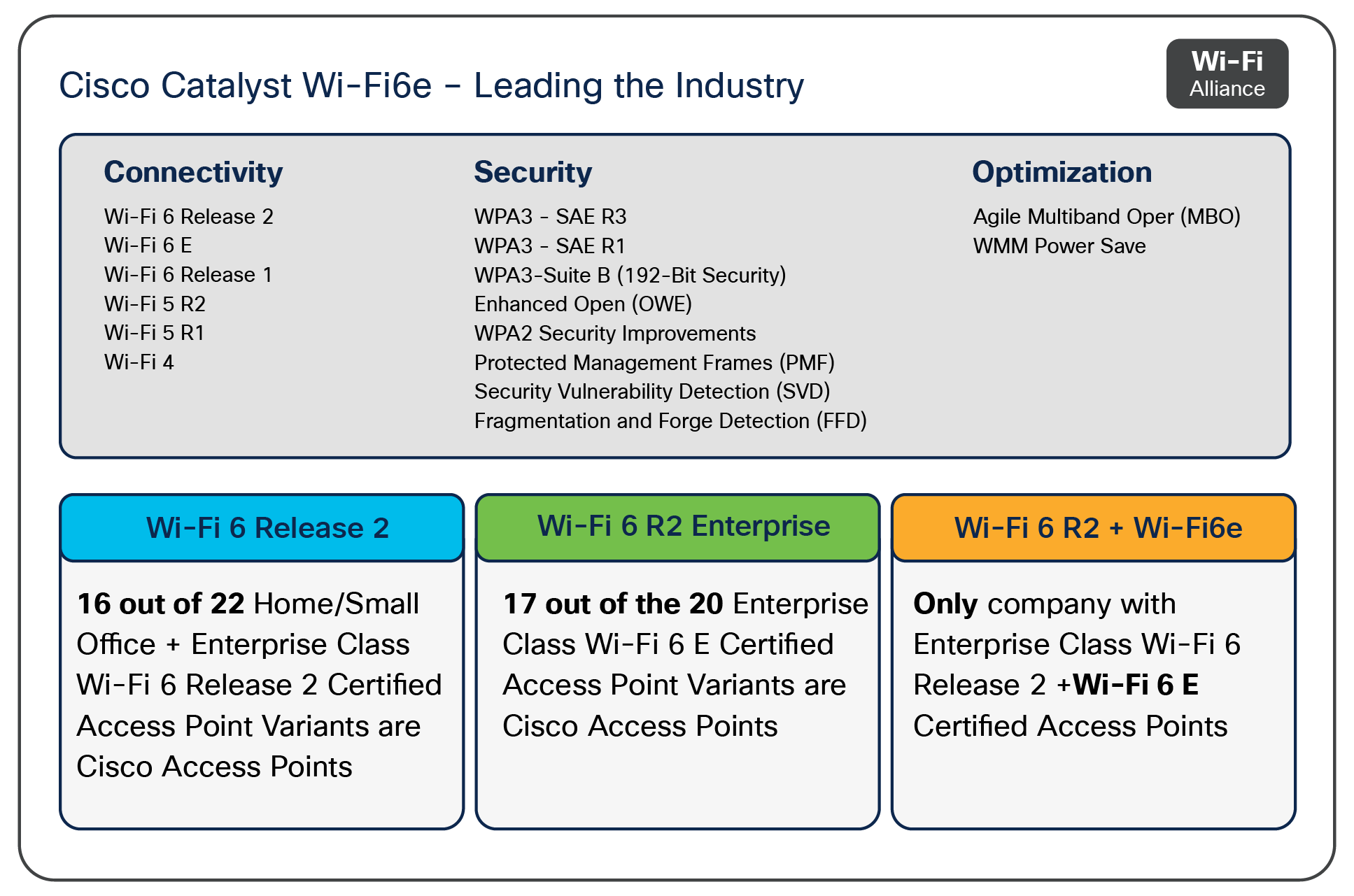6-GHz Unlicensed Spectrum Regulations and Deployment Options White Paper
Available Languages
Bias-Free Language
The documentation set for this product strives to use bias-free language. For the purposes of this documentation set, bias-free is defined as language that does not imply discrimination based on age, disability, gender, racial identity, ethnic identity, sexual orientation, socioeconomic status, and intersectionality. Exceptions may be present in the documentation due to language that is hardcoded in the user interfaces of the product software, language used based on RFP documentation, or language that is used by a referenced third-party product. Learn more about how Cisco is using Inclusive Language.
Wi-Fi 6 introduced many new enhancements to wireless networks. Wi-Fi 6E builds upon these enhancements with the addition of the 6 GHz spectrum.
A 2020 statement by former U.S. Federal Communications Commission (FCC) Commissioner Michael O’Rielly[1] on the potential uses of this band clearly states the need for 1200 MHz of this bandwidth for unlicensed use. The usefulness of this unlicensed spectrum to help meet the increasing demand for Wi-Fi (“almost 50 percent of total IP traffic will be Wi-Fi within the next two years”), to maintain connectivity in times of isolation, and to provide underserved communities with broadband access are just a few advantages available with the additional spectrum.
It is easy to find blogs and papers discussing why Wi-Fi 6E, and specifically the 6 GHz spectrum, offers many advantages for Wi-Fi deployments. These papers discuss the most valuable capability of Wi-Fi 6E, which is the additional spectrum in the 6 GHz range that isn’t encumbered by legacy protocols or clients. This 6 GHz spectrum provides almost three times as many channels as what is available in 5 GHz, and new security protocols introduced with Wi-Fi 6E will make this spectrum even more secure.
But what often isn’t reported is how to implement 6 GHz. In other words, what regulations apply to 6 GHz, and what can be done to get the most out of this additional spectrum? It should be noted that while not all countries have caught up to the U.S. and Canada in terms of 6 GHz spectrum utilization, and while this paper focuses on FCC regulations, many of the principles will be applicable to requirements and regulations for other countries. It should also be noted that only the U.S. and Canada currently have a strategy for standard power operation in the 6 GHz spectrum. For information on regulations in other countries, the Wi-Fi Alliance has a good reference that can be found at: https://www.wi-fi.org/countries-enabling-wi-fi-in-6 GHz-wi-fi-6e.
The primary consideration for the FCC regulations in the 6 GHz band is the protection of incumbent operators of 6 GHz spectrum. The process and regulations take a conservative approach that favors incumbent operators in almost all cases. The exception is that aggregation of power from all devices in an area is not tracked; instead, devices are considered individually. Otherwise, calculations, models, margins, etc., favor the protection of incumbents.
Who are the incumbent operators, and what can be expected in a given area? The most common type of licensed operation in these bands is point-to-point links. As an example, here is a snapshot of some of the incumbents in the Galveston, Texas, area (a coastal city) in the UNII-5 band.

Example of licensed operations
We can see in this sample that many of these licenses are for city operations, utilities, and wireless carriers. While having five pages of such licenses for one city may look intimidating, the good news is that the typical incumbent point-to-point link uses a narrow-beamwidth antenna or “directional antenna” and often has a beamwidth of only 1 degree. This means that unless an interfering source is directly in line with a deployed link, there will be a great deal of rejection of the interference.
This has an effect similar to that of looking through a high-powered telescope: objects that are directly in the line of sight are greatly magnified, but anything that is off-center, even just slightly, will not be seen. Thus, you can potentially deploy an unlicensed 6 GHz device near an existing incumbent deployment without affecting the performance of that deployment.
The incumbent also consumes a limited amount of spectrum. To return to the telescope analogy, if the telescope was being operated by someone looking for a specific color, you would have to be directly in the sight of the telescope and match that color in order to be noticed. Everything else is tuned out as background noise.
If you look at Figure 2 you will see that specific channels are used on each link. To calculate the approximate bandwidth of a given channel, you can use the following formula: Signal Bandwidth = Rate / Bandwidth Efficiency
Applying this formula to the example below shows that this link is 163 Mbps/7bits/Hz = 23.3 MHz of spectrum.
As an example, here is a typical common carrier link.

Example of a common carrier
There are three regulatory options that apply when deploying 6 GHz: standard power, low power, and very low power. We will not consider very low power in this paper (see Figure 3). Both standard power and low power are usable and effective for indoor operations. Each has advantages and disadvantages that require specific deployment conditions.
This leads to the question, which is the best option to deploy? The answer: It depends.

6 GHz frequency allocations
Table 1. Predominant Uses of the 6 Gigahertz Band
| Sub-band |
Frequency Range (GHz) |
Primary Allocation |
Predominant Licensed Services |
| U-NII-5 |
5.925-6.425 |
Fixed FSS |
Fixed Microwave FSS (uplinks) |
| U-NII-6 |
6.425-6.525 |
Mobile FSS |
Broadcast Auxiliary Service Cable Television Relay Service FSS (uplinks) |
| U-NII-7 |
6.525-6.875 |
Fixed FSS |
Fixed Microwave FSS (uplinks/downlinks) |
| U-NII-8 |
6.875-7.125 |
Fixed Mobile FSS |
Broadcast Auxiliary Service Fixed Microwave Broadcast Auxiliary Service Cable Television Relay Service FSS (uplinks/downlinks) (6.875-7.075 GHz only) |
https://docs.fcc.gov/public/attachments/DOC-363490A1.pdf.
Standard power can operate only in a subset of the 6 GHz band (the UNII5 and UNII7 bands). Standard power operates most like the existing FCC rules for 5-GHz spectrum. Effective Isotropic Radiated Power (EIRP) is the amount of power transmitted by the antenna of a device. The maximum EIRP possible is 36 dBm for either band (6 GHz adds a maximum power spectral density [PSD] of 23 dBm/MHz, which limits power for narrower band applications). However, to use these higher power levels in the 6 GHz band (UNII5 and UNII7), there must be governance to protect incumbents, as previously discussed.
The FCC has set up a framework whereby commercial entities can offer this governance as a service that will dictate how much EIRP an unlicensed device can transmit on any given channel, or whether the device will be allowed to transmit at all. This service is called Automatic Frequency Coordination (AFC). Efforts are currently ongoing to define the interaction between the AFC systems as well as between AFC systems and devices. The current effort revolves around developing the test cases for these systems, which is planned to conclude near the end of 2022.
Unlike AFC for the Citizen Broadband Radio Service (CBRS) spectrum, AFC for 6 GHz will not provide any policing between new devices being deployed. It will police only interference between new devices being added and incumbent devices.
To do this, the location of the new device must be determined with 95% confidence of reported accuracy. For example, if the accuracy reported is +/- 1 cm, the confidence that the device is within that boundary would most likely be low. If, however, the accuracy reported is +/- 1 km the confidence that the actual location is within this boundary would be very high. This 95% accuracy boundary then becomes the location from which calculations are performed to determine whether interference exists.
The calculations to determine what power level to use are based on two primary factors. First, industry standard propagation models are used, along with margin (such as indoor/outdoor loss or fade margins), to compute the potential signal seen at the incumbent’s site. Second, the signal level at the incumbent’s receiver must be at least 6 dB lower than the noise floor. This is a typical calculation used for RF measurements, in that adding a signal that is 6 dB below a given signal will increase the total signal power by 1 dB and consequently create a 1 dB loss of sensitivity to the incumbent (both in-band and adjacent channel interference is considered). Different propagation models are used depending on how far away the new device is from the incumbent, such as Near Field, Clutter Based, and Over the Horizon models).
Standard power devices can be deployed indoors or outdoors, and the height of the antenna must be reported along with the location and the previously mentioned accuracy level. Height above ground can be either automatically or manually determined. A maximum EIRP at which the device can transmit can be determined given the height, uncertainty boundaries, and appropriate propagation model. If it will meet the “6 dB below the noise floor” requirement in the incumbent’s system, the device can be permitted to operate at a given frequency.
Devices must demonstrate that they will operate at or below the power limit provided by the AFC system. In addition to this, devices must make contact with the AFC system at least every 24 hours to ensure that any changes to the incumbent’s occupancy are reflected in the power levels of the devices, or they must cease operation (up to 11:59 p.m. the day following the missed 24-hour window).
Deployments can meet the required AFC condition in different ways. A single outdoor Access Point (AP) with an internal location device (GPS in most cases) will report the location, height, and accuracy of that device. This is a straightforward implementation example. Indoor locations, however, often do not have the ability to place a GPS system at every AP or device. In this case a “proxy” can be used. This proxy performs two primary functions. First, it guarantees that the power level allowed by the AP is what the AFC requires. Second, it provides a location based on where the GPS antenna is relative to the locations of the APs. The APs’ locations relative to the GPS location will then be reported as “inaccuracies” and added to the accuracy boundary to ensure the 95% confidence level that all APs are located within this boundary[2].
It is therefore important to consider where the antenna will be located relative to the farthest AP. Placing the antenna at the corner of a rectangular building would result in a larger degree of inaccuracy than placing it in the center of the building.
The AFC system must provide a power control resolution of 3-dB increments or less and must provide a range of 21 to 36 dBm to the devices under the control of the AFC system[3]. In addition, the AFC must reflect the addition of incumbent sites within 24 hours of the incumbent reporting the additional site.
In addition to AFC requirements, there are several other requirements that apply to a standard power deployment:
● EIRP 30 degrees above the horizon must be below 21 dBm.
● Probing is not allowed (this is an effort to reduce neighbor messages).
● Hot spots are not allowed.
● Vehicular deployments (even battery-powered devices) are not allowed (except for commercial aircraft above 10,000 feet).
● All devices (or the proxy) must report their serial number and FCC ID.
● Permanently fixed client devices can be registered with AFC and transmit the same power level (under the same restrictions) as a reporting AP (these include devices such as workgroup bridges or mesh APs that are permanently fixed).
Client devices for both standard power and low power have similar requirements. They can transmit only up to 6 dB below the maximum transmit power “allowed” for the AP. If the AP is transmitting at 6 dB below its allowed maximum (such as for radio resource management [RRM] reasons), the AP and the client could transmit at the same power. The purpose of this requirement is to limit the maximum distance a client can be from an access point, but also keep in mind that most APs have at least four antennas for the receive function, which will provide a 6 dB (10log(4)) increase in receive gain (effective sensitivity) to balance the link.
November 2, 2022 the FCC released public notification announcing “conditional approval” for Automated Frequency Coordination (AFC) systems. While this does not mean the AFC system are ready for operation, it does provide the green light for public trials for each of the 13 AFC applicants to demonstrate their compliance with the commissions rules[4].
One key advantage of a low power operation is the ability to use the full 1.2 GHz of bandwidth in the UNII5 to UNII8 range. This allows the use of wider channels, where you can have up to seven 160-MHz channels in nonoverlapping operation. Why would 160 MHz even be considered for a multiclient deployment? First, with the output power defined as dBm/MHz, this allows the link to keep the same system gain no matter what bandwidth is used. This is not the case in the 5-GHz spectrum. Second, all clients in 6 GHz will support Orthogonal Frequency-Division Multiple Access (OFDMA). OFDMA uses a concept of “resource allocation” that effectively subdivides the channel. Therefore, small packets can be aggregated into the wider spectrum efficiently. In addition, low power operation does not have any AFC requirements, which simplifies its deployment model.
The requirements for low power use are as follows:
● Must be indoors (the AP is not allowed to be “weatherized”).
● Must have a permanently attached antenna.
● May not be battery powered.
● Must employ a contention-based protocol.
● Maximum EIRP is 5 dBm/MHz (discussed in more detail below).
● Client maximum power is 6 dB below the AP maximum power, similar to the requirement in standard power.
● As in standard power, mesh/extender devices can operate with the same conditions as the AP.
● Must be clearly labeled with a notice that states that “FCC regulations restrict operation of this device to indoor use only.”
The defining condition of the low power mode is a constant PSD of 5 dBm/MHz. The maximum power level for a chosen bandwidth can then be calculated as 5(dBm/MHz) + 10log(B(MHz)). This means that allowed EIRP will range from 18 to 27 dBm based on the amount of bandwidth used (20 MHz to 160 MHz). When using the higher bandwidth, this allowed transmitted power is very similar to the actual maximum transmitted power in the 5-GHz spectrum.
For outdoor deployments there is only one option: You can use only standard power with AFC. The actual transmit power will be the lesser of AFC limits and Transmit Power Control (TPC) settings. The use of external directional antennas is not prohibited with standard power deployments, but the EIRP must include the gain of the antenna.
For indoor deployments the use of low power will reduce the complexity of the deployment and can be a great solution. The tradeoffs of the various bandwidths and power levels are beyond the scope of this paper.
In many cases using wider channels, such as 80 MHz or 160 MHz, is a good option. Even if the power levels are lower at the cell edge, the additional bandwidth can often compensate for the loss in signal-to-noise ratio (and hence Data Rate/Modulation Coding Scheme). If this is a greenfield deployment, it will be best to use an RF planning tool to get an understanding of how 6 GHz can be deployed at that location.
The primary limitation when considering the use of low power indoors will be the need for external antennas. Be aware that the use of internal directional antennas is allowed under the low power limits (with the maximum EIRP as previously stated), but they must be “built into” the AP. Therefore, if the directivity of the built-in antennas of available AP models is not acceptable for the design, standard power will be required. The bottom line is that many operators will benefit from the indoor deployment of APs in low power mode because it is a more simple and flexible method. The need for external antennas or outdoor locations will drive the use of standard power, with its more complex requirements.
When the need for external antennas arises (not internal directional ones), the deployment will need to use standard power. This will drive the requirement for AFC and all the reporting functions of AFC but will allow for higher power. It should also be noted that it is not clear whether clients will be able to meet the higher power allowed with standard power, and to date the FCC is not yet approving client devices with standard power.
The client capability should always be considered, and one should not assume that client devices will be able to meet the maximum values of the EIRP for standard or low power operations. A quick survey of some of the recent FCC device approvals (low power clients) shows a great deal of variation. There have been over 100 Original Equipment certifications in the last two years in the 6 GHz low power client category.
Surveying about a dozen devices across four different manufacturers, here are some of the interesting outcomes:
● Taking the average of the devices’ mean values of power across all frequencies, bandwidths, and modulations, the output power drops by about 6.2 dB, from 5 GHz to 6 GHz (9.3 dBm at 6 GHz vs. 15.5 dBm at 5 GHz).
● Very few clients take full advantage of the PSD limits at 6 GHz.
● The output power in the 6 GHz band varies greatly, from 4 to 16 dBm, depending on device, band, modulation, etc. The 5-GHz band also varies from 4 to 20 dBm, but most values (with one exception) hover in the 14 to 20 dBm range.
● In both 5 GHz and 6 GHz, antenna gains were typically close to unity (0 dBi/-2.1 dBi) but in some cases were as low as -6 dBi. This can be cause for concern for any device, as it affects the Received Signal Strength Indicator (RSSI) of the downlink signal (transmitted power is accounted for in the numbers above).
● At the time of this writing, Apple did not have any low power devices certified.
Using this oversimplified statistical model, the takeaway would be to assume that the client will operate somewhere in the 10 dBm range maximum power and will be 5 to 6 dB lower than the existing 5-GHz clients. It is expected that this will normalize as the 6 GHz devices mature to something closer to the PSD client limits. However, if you have the desired clients, test with them, as they do vary greatly at this time. A good source of information on newly released 6 GHz clients can be found on the FCC website: https://apps.fcc.gov/oetcf/eas/.
How does this apply to Cisco products?
Today the only permitted products produced by any vendor use low power, because the AFC systems are still being developed and have not yet received FCC approval. Cisco has indoor APs that will support both low power and standard power operation when standard power becomes available. The outdoor AP model (Cisco Catalyst™ IW9167 Series) is not allowed to transmit at 6 GHz until the industry AFC system is completed. However, it comes with all necessary certifications and a GNSS receiver built in, making it ready to use when AFC is ready. In the meantime, the third radio can be used at 5 GHz to add more capacity in that spectrum.

Cisco Catalyst Wi-Fi 6E
There are currently no options for external directional antennas except for the IW9167, but there are four options at the time of this writing (the Cisco Catalyst 9162, 9164, 9166, and 9136 Series) that will offer typical indoor deployment options for 6 GHz omnidirectional requirements. When designing for coverage with 6 GHz for either standard or low power, careful consideration should be given to continuity. It is best to minimize roaming between bands, so the recommendation is to build out 6 GHz coverage within entire contiguous areas rather than having small islands of 6 GHz coverage.
The new 6 GHz spectrum is an effective way to augment your existing Wi-Fi deployment. Most will benefit from the use of the low power configuration with 80-MHz or 160-MHz channels with little or no change in AP layout today. Some may require a new AP layout, and some may require the use of standard power.
While the client space is still rapidly growing, now is the time to get started with low power and allow clients that are capable of supporting 6 GHz to enjoy the performance of Wi-Fi 6E.